BIOL 4105 Exam 3
1/244
There's no tags or description
Looks like no tags are added yet.
Name | Mastery | Learn | Test | Matching | Spaced |
|---|
No study sessions yet.
245 Terms
Platyhelminths general characteristics
-flatworms
-turbellaria (free-living)
-cestoda (tapeworms, parasites)
-trematoda (flukes, parasites)
Taxonomy of helminths
-divided into two broad phyla
a. nematohelminthes
-cylindrical worms
b. platyhelminthes
-flat or leaf like worms
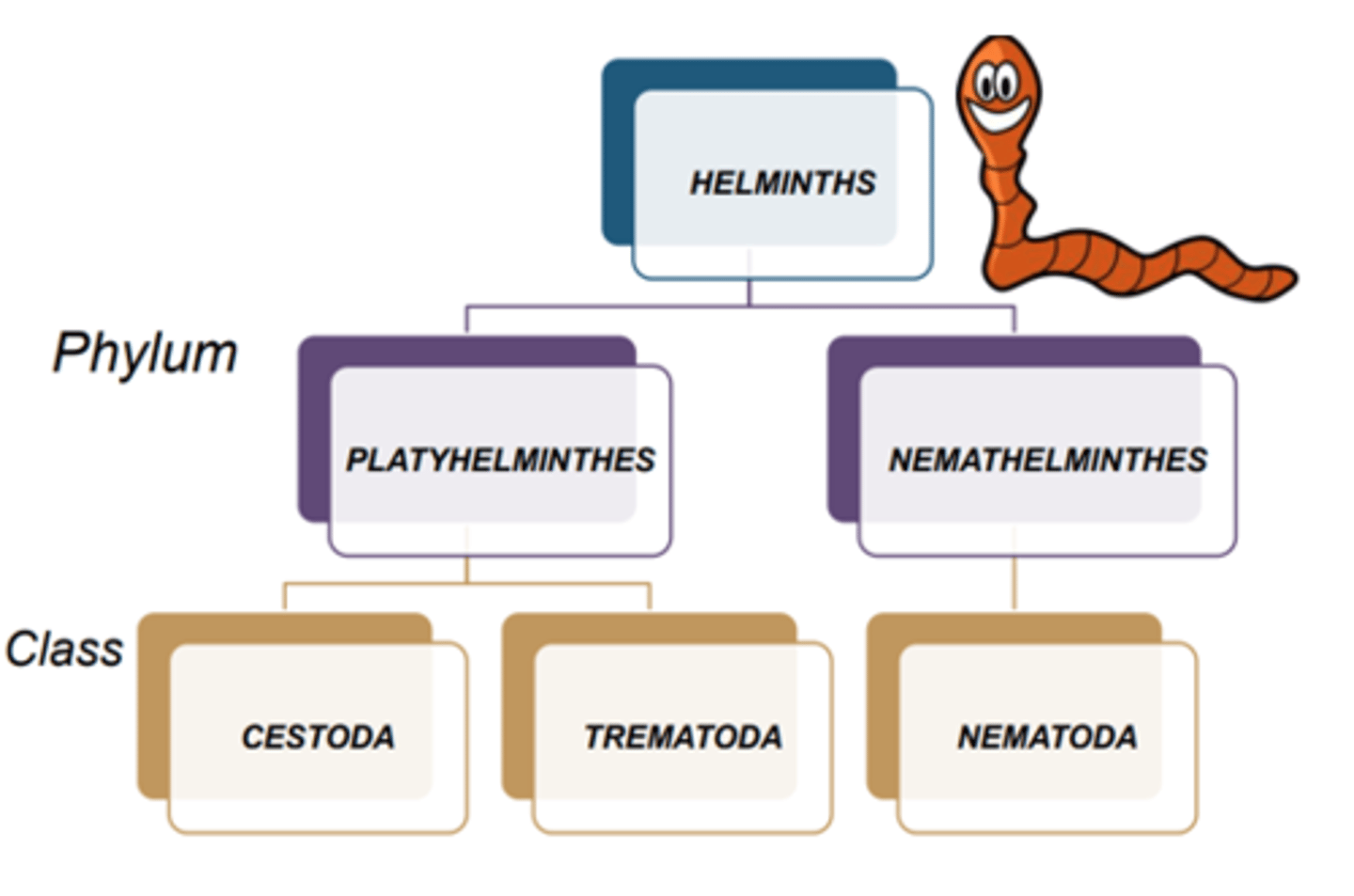
Anatomical terms
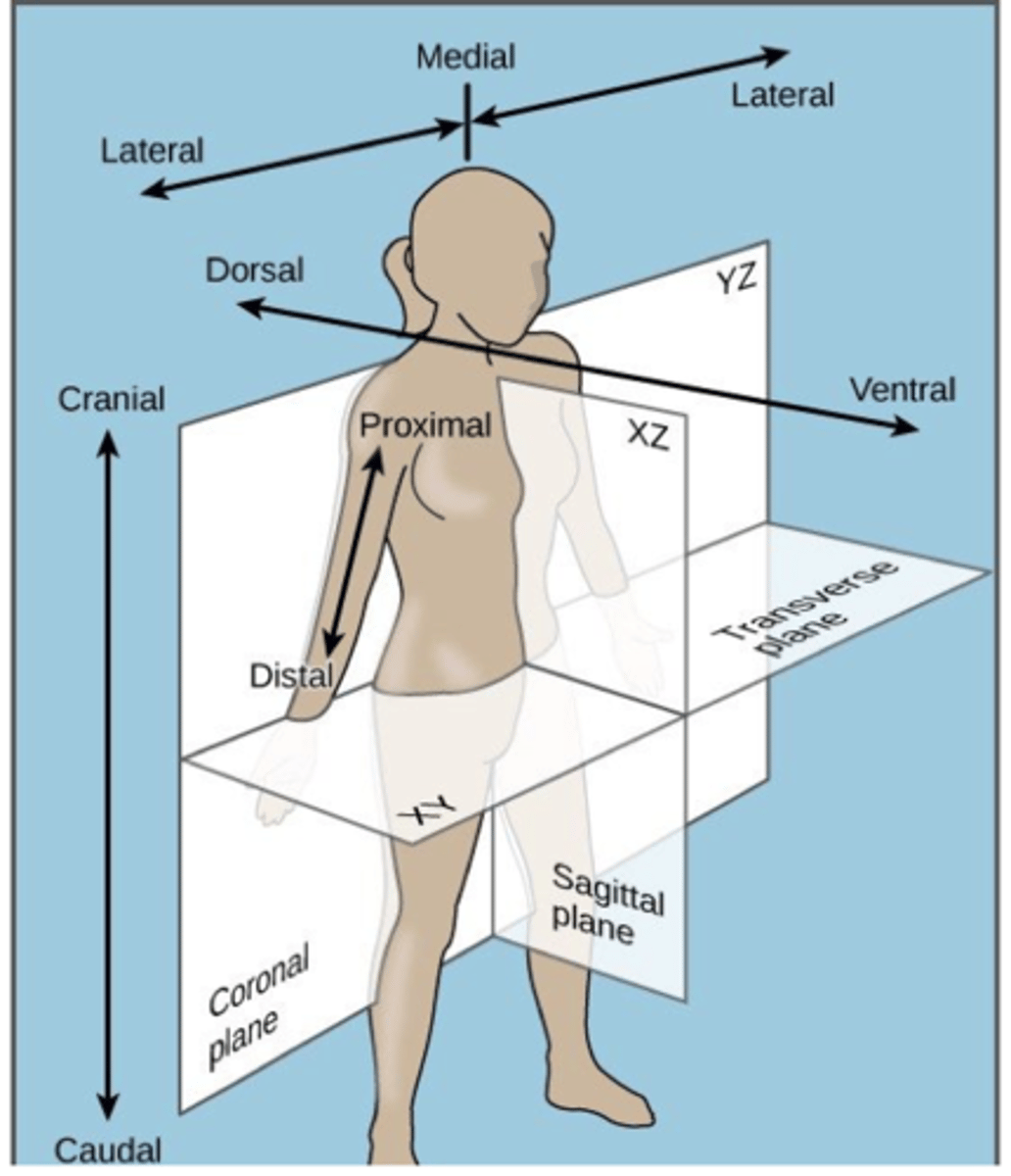
Characteristics of all platyhelminthes
-dorsoventrally flattened
a. flattened top to bottom
-bilterally symmetrical
-define anterior and posterior ends
-acoelomates
a. body cavity is solid between the outer surface and the digestive cavity
-obligate parasites
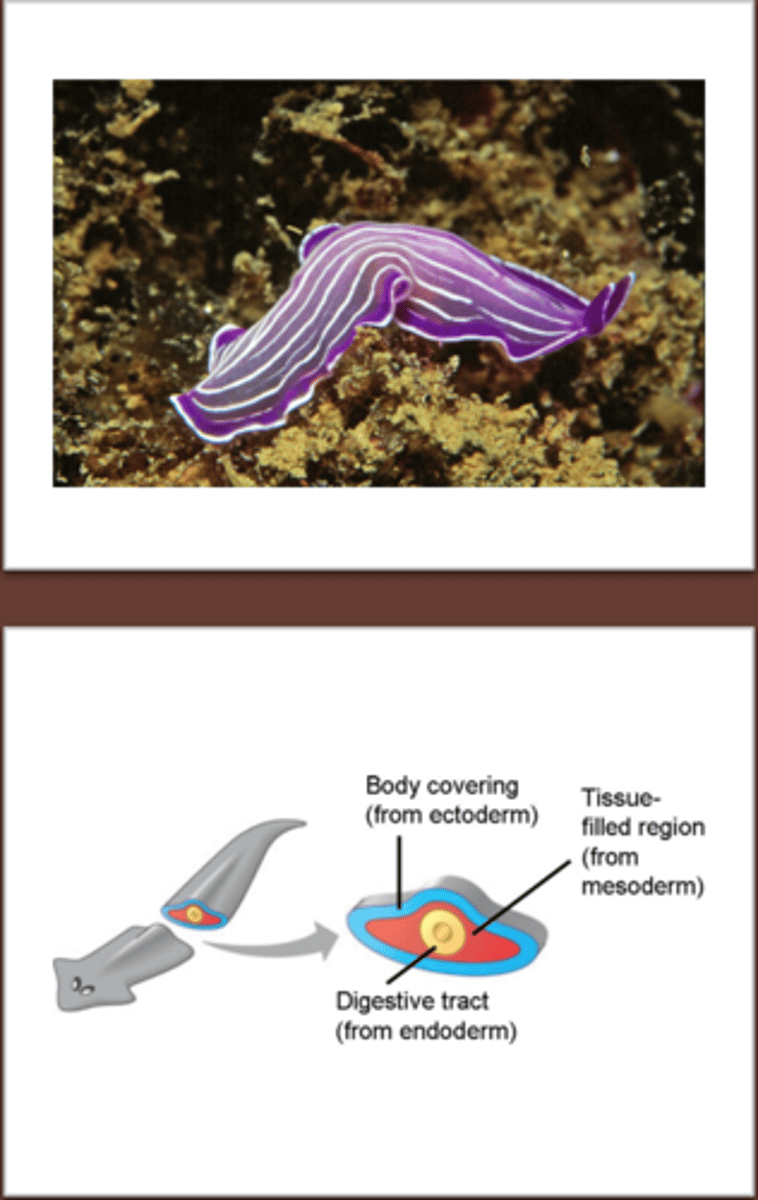
platyhelminthes cont...
-No circulatory, respiratory or skeletal system
a. use diffusion to transfer oxygen and other nutrients through their bodies.
-Digestive system*
a. primitive tube ending blind sac
b. found in trematodes
c. absent in cestodes!
-Excretory system
a. have flame cells that filter and remove excess water from the body
-Invertebrates: no circulatory system, no respiratory system and no skeletal system
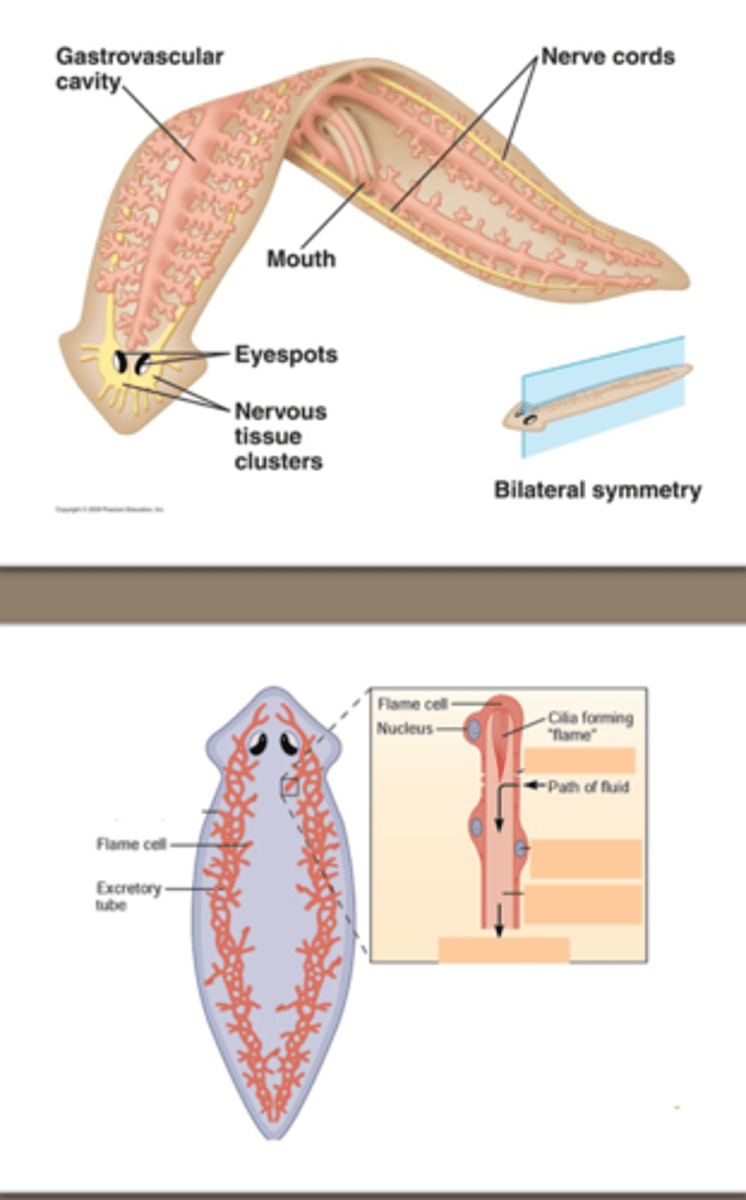
Platyhelminth reproduction
-Platyhelminthes reproduce both sexually and asexually.
-Sexual reproduction
a. Monecious
-hermaphrodites or having both male and female reproductive organs in a single individual.
-Most trematodes!
-Diecious
a. Schistosomes have separate sexes.
-Asexual reproduction
a. Fission, which is when they split in half. Mainly non-parasitic worms.
Trematodes: Common features
-They are flat with leaf-like unsegmented body,
-Have suckers (no hooks) for attachment.
-Trematodes are usually leaf shaped, and commonly named as flukes.
a. Fluke means flat body with suckers.
-No body cavity.
-Reproduction:
a. hermaphroditic (male and female systems are together)
b. schistosomes are an exception.

Adult flukes
-2 suckers (Digenea)
a. oral (anterior)
b. acetabulum (ventral)
-Digestive tract
a. oral cavity (mouth)
b. pharynx (muscular pump)
c. esophagus
d. intestinal ceca
-Nutrition
a. absorption
b. ingestion
-Primitive excretion system
-Hermaphroditic
(w/ 1 exception)
a. male and female, and cross as well as self-fertilization occurs
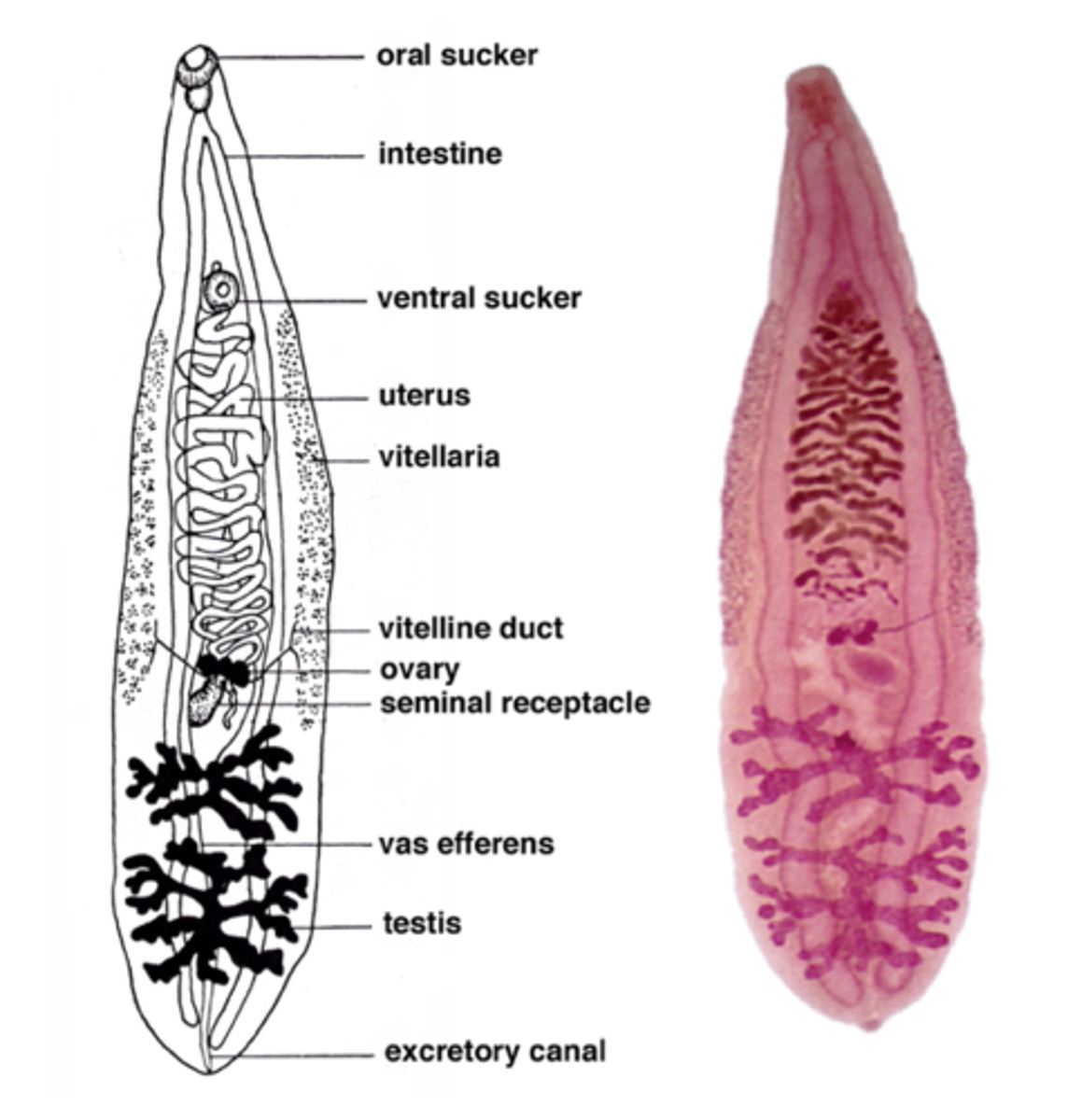
Digenetic trematodes
-phylum: Platyhelminthes
-class: Trematoda
-subclass: Digenea
-"flukes"
-Found as parasites in all classes of vertebrates
-Development requires minimum of 2 hosts
a. 1st Host - SNAIL
b. 2nd Host - Vertebrate
-Some may have 2-3 other intermediate hosts between snail & vertebrate hosts
-Digenetic: heteroxenous first host always invertebrate: snail
Trematode: 3 Reproductive Strategies
1. Self-fertilize (ex. Fasciola hepatica)
2. Cross fertilize (ex. Paragonimus westermanii)
3. "Separate sexes" (Schistosome spp --Only!)
-ALL of the above are examples of sexual reproduction.
-ALL involve fusion of sperm and egg!
General trematode life cycle
-Egg
-Miracidium
-Sporocyst or redia
-Cercaria
-Metacercaria
-Adult
trematode Egg and miracidium
-EGG
a. hatching: water is essential
b. freezing or drying out is fatal to eggs
-MIRACIDIUM
a. a ciliated, free-swimming larva
b. viable -- a few hours
c. penetrates into snail* within 30 min.
d. chemical homing device - snail mucous trail attracts
-*Alternate mode: *
a. some species the egg must be eaten by snail
for miracidium to exit!
trematode Sporocyst
-forms from the metamorphosis of miracidium in snail
-has no mouth or digestive system
-it is basically a "germinal sac"
a. undergoes asexual reproduction to produce many embryos
-depending on the trematode species determines what the sporocyst embryos develop into.
a. rediae
b. cercaria
trematode Redia
-more advanced "germinal sac"
-rudimentary digestive system:
a. mouth, pharynx, short gut
b. feed on host tissues, sporocysts, other redia
-produce embryos:
-"daughter redia"
-those develop into cercaria
-Have determined that must have a certain population of redia before the change to production of cercaria will occur. Pop. Density requirement by redia before will no longer produce daughter redia and begin producing cercaria.
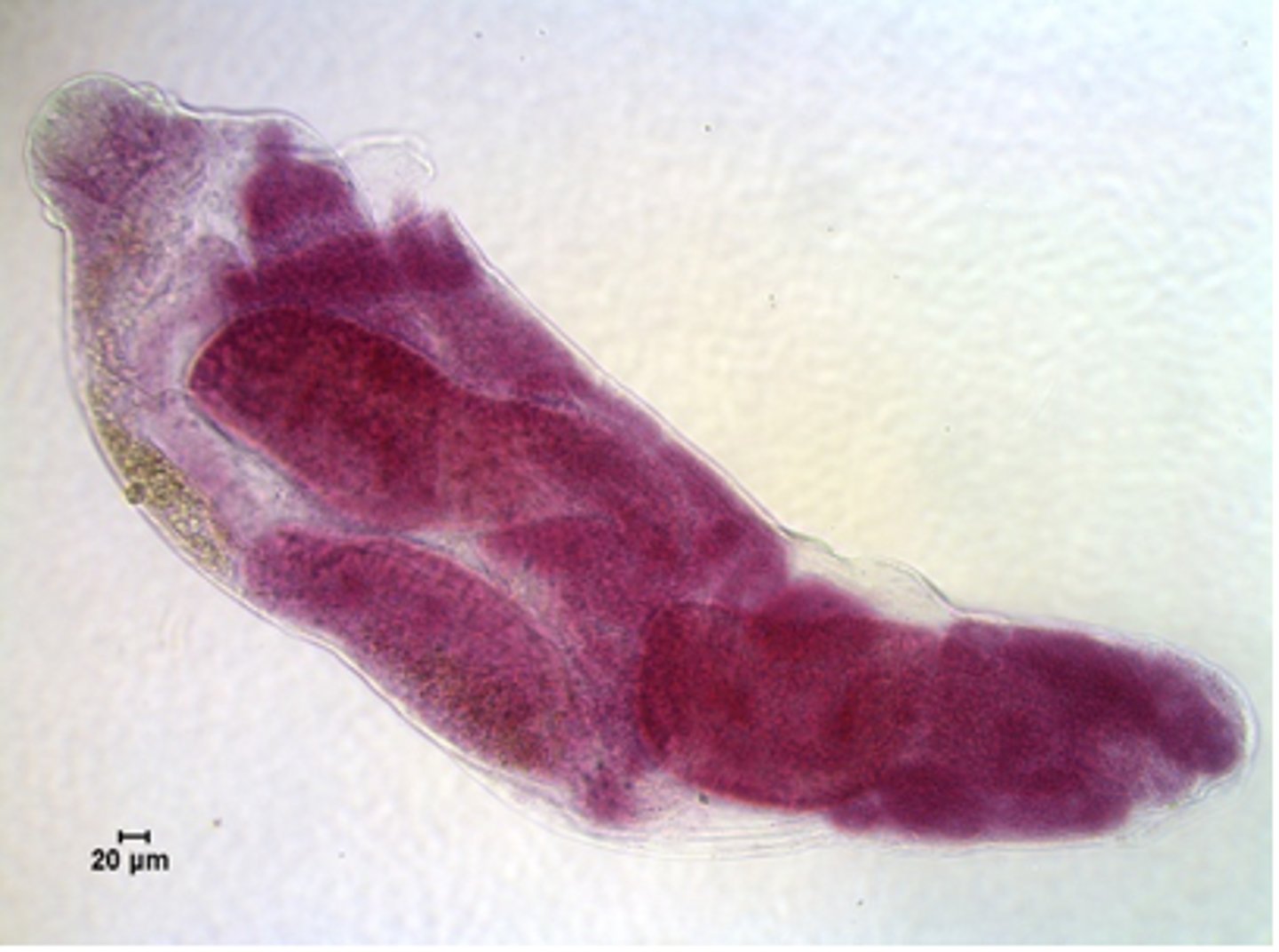
Variations on trematode life cycle
-Egg-> miracidium-> sporocyst-> redia-> cercaria-> metacercaria-> adult
-miracidium-> sporocyst-> cercaria->
-miracidium-> sporocyst-> redia-> cercaria->
-miracidium-> sporocyst-> cercaria-> metacercaria->
-miraicidum-> redia-. cercaria-> metacercaria->
trematode Cercaria
-juvenile stage
-have "mouth" and digestive system
-have "penetration" glands at anterior to
a. escape from snail
b. gain entry to vertebrate host
-In schistosomes, this is infective stage for vertebrate host
-Without tails, creep along until eaten by another host or alternately some species will attack another host and encyst in viscera and muscle.
trematode Metacercaria
-METACERCARIA (juvenile)
-Encysted form
a. in an intermediate host
-if has 2nd intermediate host)
b. on aquatic vegetation
-if has no 2nd intermediate host)
-must be ingested by vertebrate host.

How trematodes infect definitive host
-Direct penetration via cercaria
-Ingestion of metacercaria on plants
-Ingestion of metacercaria in intermediate hosts
Classified on vertebrate host niche (trematodes)
-Blood Flukes
-Liver Flukes
-Intestinal Flukes
-Lung Flukes
Schistosomiasis
-Waterborne disease in Africa, Asia and Latin America
-Estimates show that at least 229 million people required preventive treatment in 2018.
a. Most are symptomatic
b. About 20% have severe disease
-Schistosomiasis transmission has been reported from 78 countries.
Nomenclature trematodes
-Phylum: Platyhlminthes
-Class: Trematoda
-Family: Schistosomatidae
-Genus: Schistosoma
-Species:
a. haematobium
b. mansoni
c. japonicum
Three major species that causes shistosomiasis
-Schistosoma haematobium
a. Africa, Middle East
-Schistosoma japonicum
a. Endemic in China and Far East Islands
b. Eradicated in Japan in 1977
-Schistosoma mansoni
a. Africa, Middle East
b. Caribbean
c. S. America
Host niches for the blood flukes
-Schistosoma haematobium
a. urinary bladder veins
-no known animal reservoirs
-urinary tract disease
-Schistosoma japonicum
a. superior mesenteric veins
-"zoonosis"
-major reservoirs: cattle, water buffalo,
-Schistosoma mansoni
a. inferior mesenteric veins
-no significant animal reservoirs
-intestine and liver disease
Schistosoma Anatomy
-The venous blood from the GI tract drains into the superior and inferior mesenteric veins.
-These two vessels are then joined by the splenic vein to form the portal vein.
-On entering the liver, the blood is screened by macrophages (Kupffer cells) to remove any pathogens that manage to get past the GI defenses.
-Liver is extremely important. It receives all molecules absorbed from the GI tract, metabolizing, modifying, detoxifying and controlling distribution to rest of body.
-This is why the eggs of these species become trapped in the small venules of the liver.
-Mesenteric tissues are the connective tissues holding organs in place in the abdominal cavity. They are highly vascularized.
Schistosoma unique morphology
-Lack muscular pharynx
-Internal cecum reunite after bifurcation.
-These are flat leaf shaped helminths
-They just roll up!
-Eggs tell you species!
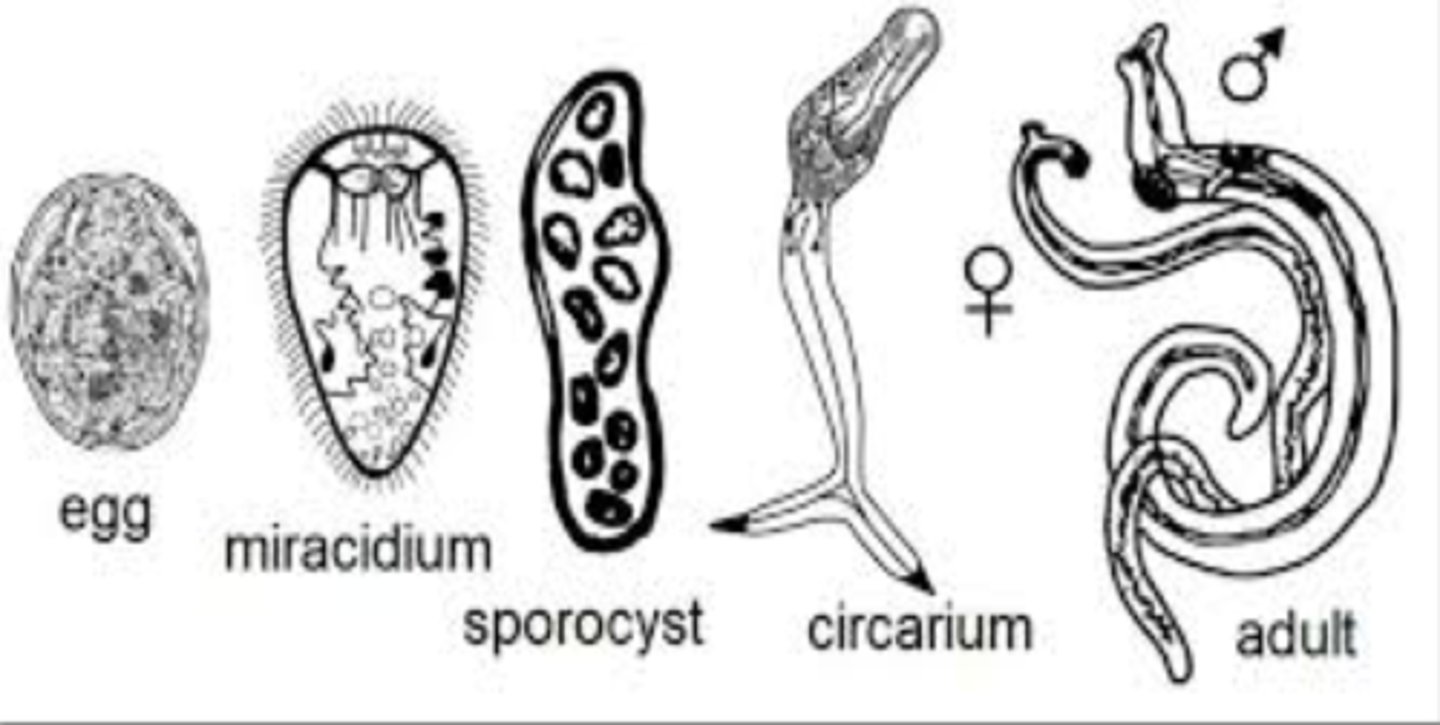
Morphology adult schistosoma
-Male is broader than female
-Lateral borders rolled ventrally into a cylinder which produces the gynocophoric canal
-This longitudinal split is how it gets its name (Greek)
a. Schisto: split
b. Soma: body
Schistosoma reproduction
-Dioecious: separate sexes
a. pair up & remain paired for life
b. female remains in the male's gynecophoral canal to survive
c. Sexual reproduction occurs in definitive host
d. Asexual occurs in intermediate host
Comparison of schistosoma eggs
-S. manoni
a. Ovoid with lateral spine (stool)
-S. haematobium
a. Ovoid with terminal spine (urine)
-S. japonicum
a. Round with lateral knob (tissues)

Schistosoma egg
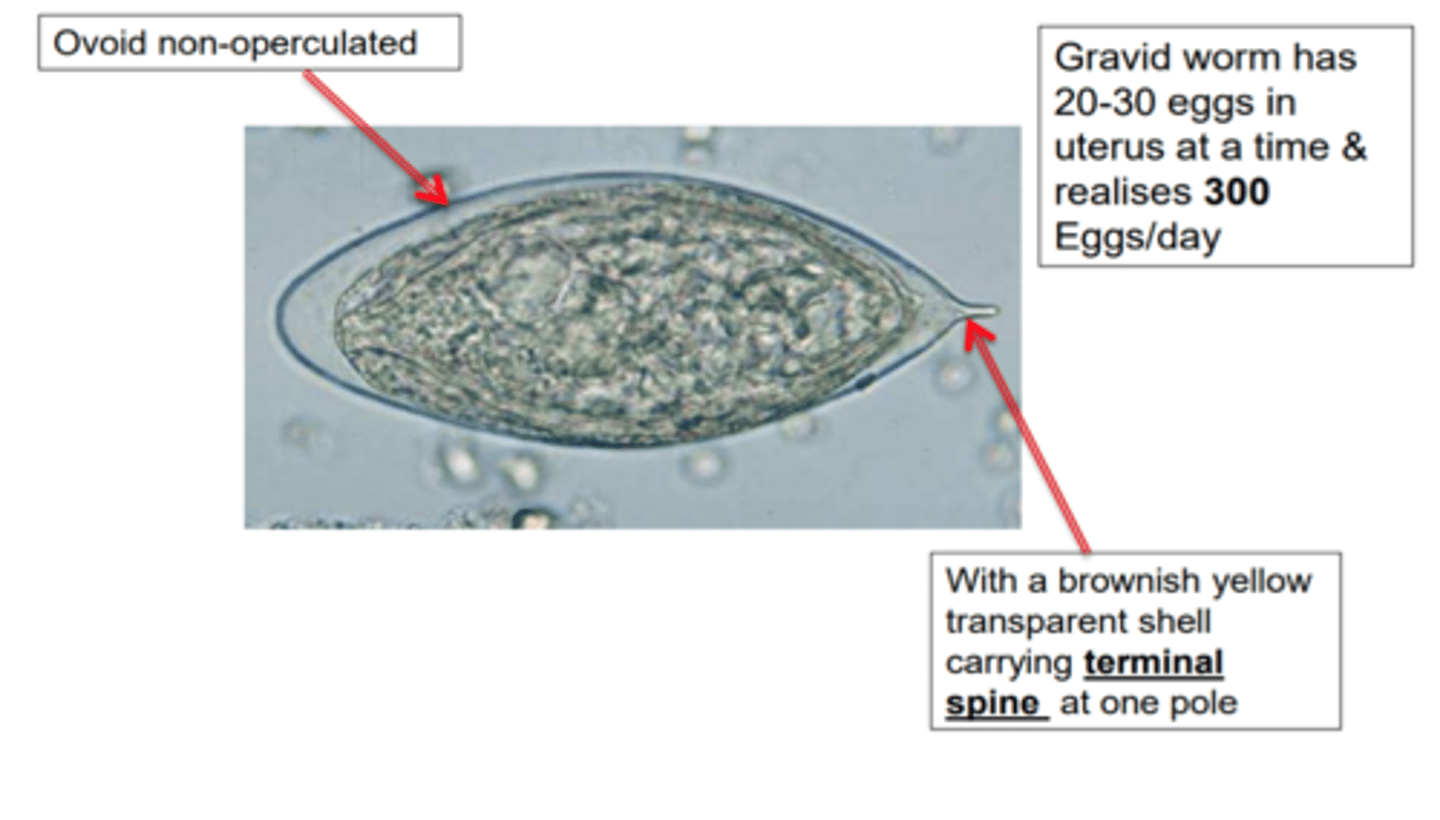
Schistosome life cycle
-Egg-> Miricidium-> Sporocyst (2 generations)-> Cercaria-> Adult
-Intermediate Host: Snail
-Definitive Host: You!
-Infective stage: Cercaria
-Host niche: vascular system in veins
-Eggs are excreted into water
-They hatch into mircadium which then find the intermediate host aquatic snail
-Asexual reproduction occurs in two rounds of sporocysts (mother and daughter)
-Takes about 4 weeks.

Miracidium
-Each miracidium gives rise to only one sex
-More than one miracidium will infect a single snail.
-One miracidium will undergo two sporocyst generations to produce about 4000 cercaria - all of one sex.
-The downside if the snail is infected with 10-12 miracidium those will produce 45,000 cercaria within snail which will kill the snail.
Intermediate snail hosts
-S. mansoni -- Biomphalaria spp
-S. japonicum - Oncomelania spp
-S. haematobium - Bulinus spp
-NO snails in USA can be intermediate host for human schistosome species!
Sporocysts
-Asexual reproduction in snails
a. Mother sporocysts form in the foot of the intermediate host and daughter sporocyst are formed in the germ cell
b. Daughter sporocysts (YDS) form in the liver and will give rise to cercaria
Cercaria
-Develop in the daughter sporocyst
-Penetrate the snail
-Free swimming
-Attracted to pheromones of skin
-Penetrate skin
cont...
-4 weeks to develop in snail
-It penetrates through the snail host to exit in response to sunlight
-Forked tail
-Short lived
-It is free swimming.
-Hangs around close to top of water.
-Penetrate skin of vertebrate host
Penetration of cercaria
-Cercaria penetrate skin and lose tails this is the schistosomulum.
-The schistosomulum moves to the dermis
-Penetrates and enters blood.
-Dendritic cells are activated, and inflammatory responses result in pathology.
Schistosomula (larvae)
-Travels through lung, heart and onto the portal vein where they mature and pair off.
-Pairs migrate to final mesenteric vessels
-Female releases eggs which penetrate intestine or bladder
-Human cycle 8 wks
-Adult parasites very long lived reported 30 years (avg 5-8 yr)
Immune evasion and pathology
-Adults hide from host
a. Coating of serum proteins
b. MHC I mimic
-Eggs
a. cause direct tissue trauma
-Eggs secrete SEA's: Soluble Egg Antigens
-Proteolytic enzymes
b. trigger host inflammatory and immune responses
c. Granulomas can form around egg and some become calcified
Three stages of schistosomiasis
-acute
-intermediate
-chronic
Acute schistosomiasis
-Response to cercaria
-Initial penetration of skin by cercariae results in hypersensitivity and a transient pruritic, papular skin rash (swimmer's itch).
-Pruritic rash is defined as an unpleasant sensation of the skin that provokes the urge to scratch.
-A maculopapular rash causes flat and raised lesions on the skin
Intermediate stage schistosomiasis
-schistosomulum enters the bloodstream and migrates through the lungs to final niche.
-Katayama fever
a. four to 8 weeks after exposure, an acute illness can develop as eggs are laid
b. manifested by fever, malaise, cough, rash, abdominal pain, diarrhea, nausea, lymphadenopathy, and eosinophilia.
-With heavy infection due to S. mansoni or S. japonicum, a mucoid bloody diarrhea accompanied by tender hepatomegaly occurs.
Chronic schistosomiasis
-retained eggs induce the formation of eosinophilic granulomas, fibrosis and scarring
-mediated by cytokines and involves T helper lymphocytes.
Schistosoma bladder
-S. hematobium eggs get trapped and the immune response produces bladder lesions with hemorrhage and obstruction.
a. the bladder becomes inflamed and fibrotic from granuloma formation and eventually calcifies
-Symptoms and signs
a. dysuria
b. rrgency- results from the loss of elasticity
c. microscopic developing into gross hematuria
d. secondary urinary tract infections
e. nonspecific pelvic pain.
f. Squamous cell carcinoma is often associated with chronic infections
Bowel
-blockage and ulceration of the bowel wall
a. from granuloma formation forms large polyps obstructing egg movement
b. S. mansoni and japonicum
-Chronic infection can lead to abdominal pain and bloody diarrhea.
a. anemia and iron deficiency can occur especially in children
b. May not see eggs in stool in chronic infections with large granulomas or obstructon
c. Have to do rectal snip
Liver
-eggs deposited in the intestinal veins are carried by portal blood flow to the liver inflammatory reaction results in periportal fibrosis and hepatic enlargement.
-Portal hypertension can develop and cause hepatosplenomegaly, ascites, and esophageal varices.
Chronic fibrosis in liver causes ascites
Lab diagnosis
-detection of egg
a. urine microscopy
b. bladder mucosal biopsy
-detection of antigen
a. circulating anodic antigen and circulating cathodic antigen by ELISA
-detection of antibody
a. complement fixation test (CFT)
b. immunofluorescence
c. indirect hemagglutination
d. bentonite flocculation test
e. enzyme linked immunoelectrotransfer blot
f. FAST/ELISA
Schistosoma diagnosis
-Dx: finding characteristic eggs:
a. in urine S. haematobium** ovoid, terminal spine
b. in feces S. japonicum round, +/- spine
c. in feces S. mansoni ovoid, lateral spine
-With buildup of chronic fibrous tissue in gut and bladder
-> stops egg passage: few to none in feces or urine
-- rectal biopsy to find trapped eggs
-- bladder biopsy to find trapped eggs
--ELISA tests available only at CDC
1) tests for host antibody
2) tests for worm antigens - best!
Schistosoma treatment
-Praziquantel
-1 dose kills all adults
-- Efficacious
-- Ease of Rx
-- Low number of side effects
-- Low cost
MOA (mechanism of action): disrupts Ca++ transport
across parasite membrane
Has dual effect:
1)disrupts parasite's tegument - "unmasks" worm
(loses its coating of your proteins)
2) disrupts nervous system of worm
Praziquantel
-Praziquantel affects the transport of calcium ions across the membrane of the parasite. The dual effect of this drug is to 1) disrupt the integrity of the parasite's tegument [cannot hide any more] and 2) to disrupt the flow of calcium ions in the nervous system of the worms. Have discovered that certain calcium blocker drugs used in humans to treat heart disease are also effective against schistosomes. Interfere with calcium uptake and prevent egg production. Do not kill adults but stop all egg production and associated pathology. Thus stop disease and transmission. Question now is how effective is it really? Does it stop all egg production, or just some of it?
Liver flukes
-Fasciola spp.
Fasciola spp. overview
-Family: Fasciolidae
a. Fasciola hepatica
b. Fasciola gigantica
c. Fascioloides magna
d. Fasciolopsis buski*
All are liver flukes except Fasciolopsis buski which is an intestinal fluke
-All: an aquatic snail - intermediate host
Fasciola hepatica and gigantica
-Common name: Sheep liver fluke
-largest and most common liver fluke
-primarily found in domestic and wild ruminants (their main definitive hosts) but also are causal agents of fascioliasis in humans
-Causes "liver rot" in sheep
-Fasciola gigantica not usually human pathogen
Fasciola gigantica
-not found in continental USA
-does infect humans
Fascioliasis overview
-all continents except Antarctica
-people usually become infected by eating raw watercress or other water plants contaminated with metacecariae.
-The young worms move through the intestinal wall, the abdominal cavity, and the liver tissue, into the bile ducts, where they develop into mature adult flukes that produce eggs.
-The pathology typically is most pronounced in the bile ducts and liver.
Fasciola hosts
-Intermediate host:
a. Lymnaea spp (here in LA)
(many different species of snails worldwide including other genera)
-Definitive hosts: sheep, cattle, humans
-Host Niche: liver-> bile ducts
Fasciola morphology
-Large (35mm)
-Cone shaped anterior end w/ shoulders
-Leaf shape
-When you look at the morphology of the adult fluke they are hermaphrodites but the internal organs are often obscured by extensive vitellaria . They are "leaf shaped" and have a very easily seen anterior due to "shoulders". These are large flukes which can be seen with the naked eye.
Fasciola life cycle
-Metacercaria excysts in duodenum
-penetrates gut wall
-crosses peritoneal cavity
to liver
-matures in bile duct
-adults burrow through
liver during life span
-feed on liver cells and bile duct epithelium
-create necrotic tracks in
liver
-eggs out via bile duct to
GI tract à out in feces
-eggs released into tracks in liver are trapped there
-Life span: up to 11-12 years
cont...
When we look at the life cycle, 1) unembryonic eggs are passed in feces into water. So they have to mature in water (2) and this takes about 10 days. 3) The miracidia hatch and penetrates the first intermediate the Lymnaea snail. Within the cell you have the sporocyst, Redia (2 rounds) and Cercaria (1-2 months). The free swimming cercaria encyst on water plants and can survive for long periods of time. This is the metacercaria stage. When humans or ruminants ingest the metacercaira on the aquatic plants, the metacercaria excyst in the small intestine. They pierce the wall and escape into the peritoneal cavity. They then penetrate the liver and make their way to the bile ducts (see anatomical reference). They will mature into adult worms in about 3-4 months and begin laying eggs. The adults feed on cells of the liver and bile duct. They are large so they can induce mechanical damage and necrosis. You can see "pipe lines" or pipe stem fibrosis over time (chronic infections) where they have traversed the organs.
Fasciola life cycle stages
-egg-> miracidium-> sporocyst-> rediae-> cercaria-> metacercaria-> adult
-metacercaria: infective stage for vertebrate host
Parasite verses host
-Adult flukes: feed on bile duct epithelial cells
a. secrete proline (an amino acid)
b. proline causes bile duct epithelium to proliferate (hyperplasia)and cells to enlarge (hypertrophy)
c. Causes epithelium to produce collagen
d. This expansion allows them to have more cells to eat
-"gardening in your bile ducts"
Fascioliasis phases
-Acute phase: Migration
-fever, nausea, internal bleeding, skin rashes, stomach pains.
-start about four to seven days following the initial infection and last a couple weeks to a couple months.
-Chronic phase: adult flatworms lay eggs
-stomach pains, anemia, pancreatitis, hepatomegaly, jaundice, and biliary obstruction
Damage and obstruction in a bile duct
-Moth-eaten appearance is actually damage to epithelium with
lesions penetrating through the lining of the duct.
-In the bile duct as they traverse feeding upon our tissues they can cause this "moth -eaten" appearance of the bile duct.
Pathology-fibrosis
-Pipe stem fibrosis around bile ducts!
-NO portal hypertension! Blood vessels NOT involved
Fasciola diagnosis and treatment
-Dx: Eggs in fecal sample
-Rx: Triclabendazole
a. interferes with microtubule formation
b. stops all cellular functions requiring microtubules
(cell division, protein synthesis, membrane transport, reproduction, etc.)
-This is the one fluke for which Praziquantel is NOT the DOC!
-Why is praziquantel not used for F. hepatica? *
1st: Requires 100X normal dose to have any effect
2nd: That dose still does not kill ALL parasites
3rd: That dose greatly increases drug side effects
Fasciola diagnosis
-Eggs in fecal sample
-F. hepatica eggs (resemble hookworm eggs ) but have operculum (lid or cap)
-Eggs are oval with little caps. So they appear like they have an outer shell They are bile-stained and will appear brownish.
Pseudofascioliasis
-False positive for infection with Fasciola hepatica
-Results from of eating infected beef or sheep liver w/eggs
a. eggs will pass on through GI tract and into feces
b. recheck after liver free diet for 2 weeks
-Why can you not get infected from this infected liver?
Fascioloides magna “Liver fluke”
-Similar to F. hepatica (life cycle & size)
-Adults replicate in liver and not bile ducts!
-No infection in humans
-Hosts: Deer, Elk, Caribou (cervids)
a. Cattle-> dead end hosts
b. Sheep-> dead hosts!
c. Infected sheep die!
-Produces Melanin pigment- black tracks in liver
Fasciolopsis buski
-Intestinal Fluke
-Common in China and Southeast Asia
-In endemic regions: up to 60% infection rate in people
-Found in humans and pigs
-Largest fluke to infect humans - can be >3 in. long
-Fecal contamination of H2O required
-Ingest metacercaria on aquatic plants
-Host Niche: GI tract - small intestine
Anatomy of Fasciolopsis buski
-Different from other fasciolid flukes:
1. Intestinal fluke
2.No tissue migration
3.No cephalic cone (no shoulders)
Life cycle of Fasciolopsis buski
-Several snail varieties as hosts
-Prolific egg producers: 25,000/day
Clinical disease
-Light infection -asymptomatic
-Heavy infection-> CLINICAL SIGNS
a. abdominal pain
b. diarrhea w/ mucus*
c. Interfere with digestion/nutrient absorption
-Remember: Lots of mucus in feces often 1st indication there is gut irritation from something - such as a parasite
Pathology caused by Fasciolopsis buski:
1) Direct Trauma:
- feed on small intestine epithelial cells
- cause ulcers in gut mucosa
- interfere with digestion & absorption
2) Gut Obstruction:
-in very heavy infections can physically block intestine (a big fluke!)
3) Immunopathologic: allergy to worm products
- has caused fatal anaphylaxis in a few individuals
- very RARE effect!!!
Why a persistent high infection rate in endemic regions?
-Aquatic cultivation - is economically important
-Fertilizer: human feces
Fasciolopsis buski diagnosis and Treatment
-Dx: eggs in feces
(indistinguishable from F. hepatica eggs)
-How would you distinguish which is which?
-Remember host niche for each:
a. F. hepatica – liver damage
b. F. buski - gut damage & diarrhea
-Rx: Praziquantel
-Prevention: -1) boil veggies for a few seconds before eating
-2) proper disposal of feces
-Transmission: human feces as fertilizer in aquaculture-> biggie!
Plagiorchiformes Opisthorchiformes
-Require a 2nd intermediate host required
1. Cercaria-> infect 1st intermediate host (snail)
2. Metacercaria-> 2nd intermediate host!
a. Must eat 2nd intermediate host to eat metacercaria
-For trematodes of these orders infect a variety of vertebrate definitive hosts. One common feature is that their cercaria must encyst in a second intermediate hosts. The infectious stage in when the second intermediate host is devoured. Second of the three families with significant liver flukes: 1) Fasciolidae 2) Dicrocoeliidae and 3) Opisthorchiidae.
Family: Dicrocoeliidae
-No aquatic component in life cycle
a. Broken its ties to a body of water!
-Terrestrial (land) snail -- intermediate snail host
-Eggs -- must be eaten by snail host
-Second of the three families with significant liver flukes: 1) Fasciolidae 2) Dicrocoeliidae & 3) Opisthorchiidae. This family is unique in that there is no aquatic intermediate host or water needed for its life cycle. It's first intermediate host is a land snail. The snail must consume the eggs.
Dicrocoelium dendriticum
-Known as the lancet fluke
-Liver fluke of sheep à bile ducts
-Distribution: Europe, Asia, N. Africa, North America and Australia
-Definitive hosts:
a. Herbivores
b. Uncommon in humans but does occur
-Dicrocoelium dendriticum is known as the "lancet" fluke because of its shape. The bottom is a medial lancet for illustration purposes. It is found throughout Europe, Asia, North African, North American and Australia. The definitive hosts are herbivores. It is uncommon in humans but it does occur. See the image at the lower right which shows medical lancets-finger prick tools. At the topi s Dicrocoelium dendriticum. This liver fluke prefers the bile duct of sheep and other herbivores. Its distributions range includes Europe, Asia and North Africa. You can also find this in North America and Australia. The definitive host are grazing herbivores like sheep. It is uncommon in humans but does occur.
Life cycle of Dicrocoelium dendriticum
-Two intermediate hosts:
a. 1st - land snail
-not specific with regard to snail hosts
-Cionella lubrica most common in USA
-2nd - common brown ant
a. Formica fusca
-The Life cycle of Dicrocoelium dendriticum does include TWO intermediate hosts the first being a land snail. There isn't a specific group but Coinella lubricant pictured is the most common in the US. It's second intermendiate is a brown ant of the Formica spp. This will get interesting!
cont...
-Eggs are passed with the feces of the host sheep • Eggs containing miracidia are consumed by snails; mother sporocysts give rise to daughter sporocysts which in turn give rise to cercariae • Cercariae accumulate in the mantle cavity of the snail and act as an irritant • They become encased in mucous and are deposited from the snail as a slime ball
-Slime balls are eaten by ants with most of the resulting metecercariae encysting in the hemocoel of the ant • A few metecercariae encyst in the ganglia of the host ant, taking over their brains ("brain worms")• Behavior of the ant becomes altered (cling to blades of grass in the evening) and ants are readily consumed by grazing animals. They cause tetanic spasms in ant's mandibular (jaw) muscles which will not let go until temp arises again in the morning. Animals tend to graze in cooler times of day: dawn and dusk
• • Metacercaria excyst in the intestine of the heribivores and migrate to the bile duct and liver.
Dicrocoelium spp. definitive host
-Metacercaria-> up common bile duct to liver
-Adults in bile ducts: inflammation and fibrosis
-Heavy infection affects liver and gall bladder functions
a. impede bile flow
b. interfere with fat digestion
-Like F. hepatica, Dicrocoelium dendriticum impede bile flow and ultimately cause congestion in liver and affect gall bladder
-FYI: Liver produces bile which flows through bile canaliculi into biliary tree hepatic ducts where it can go to the gall bladder which concentrates and stores the bile. When fat is eaten, the gall bladder releases the bile back into the common bile duct (hepatic and cystic ducts become one) which opens into the small intestine where it facilitates digestion and absorption of the fat as triglycerides and glycerol.
Dicrocoeliasis
-The infection in humans can also spread from eating raw or undercooked liver of infected animals
-The presence of the parasite in the bile duct is the cause of most symptoms associated with Dicrocoeliasis
-Dicrocoeliasis in humans can occur when raw or undercooked liver of an infected animal is consumed. The metacercaria escape and migrate to the liver and bile ducts. The host mounts an in immune response to eliminate the flukes.
Signs and symptoms of dicrocoeliasis
-Symptoms that are common for most mild cases of infection include:
a. Bloating
b. Diarrhea
c. Dehydration
-If infestations are severe (in rare cases)
a. Blockage of bile ducts
-Hepatomegaly or enlargement of the liver
-Cholecystitis or swelling of the gallbladder
-The signs and symptoms of Dicrocoeliasis vary in occurrence and severity depending on the duration and magnitude of infestation by D. dendriticum. Symptoms that are common for most mild cases of infection include: bloating, diarrhea, dehydraton. If infestations are severe (in rare cases), a consequential enlargement of the bile ducts can cause the following:
Hepatomegaly or enlargement of the liver
Cirrhosis or inflammation/low function of the liver, which can be associated with liver abscesses and pain in the upper abdominal area
Cholecystitis or swelling of the gallbladder
Dicrocoelium spp.
-Dx eggs in feces
(False positives in humans eating infected liver*)
-To get infected: eat an ant!
Metacercaria = infective stage for you!!
(most recent human case in USA diagnosed in New Jersey)
-Rx: Praziquantel
-Diagnoses by eggs in the feces. Sometimes you can get false positives by eating infected liver. Metacercaria are the infective stage by consuming the intermediate host: ants! There have been a human case in New Jersey. Most cases occur in Europe, Asia and Africa and Russia has a high number of reported cases. The treatment is praziqantel.
Family: Opisthorchiidae
-Aquatic snail -- intermediate snail host
-Eggs -- must be eaten by snail host
-Third of the three families with significant liver flukes: 1) Fasciolidae 2) Dicrocoeliidae & 3) Opisthorchiidae. It's first intermediate host is an aquatic snail. The snail must consume the eggs.
-The liver flukes (Digenea) of the genera Clonorchis and Opisthorchis are notorious as causative agents of human infections transmitted by fish
Clonorchis sinensis
-Host niche: Bile ducts in liver
-1st Inter. Host: aquatic snail
-2nd Inter. Host: freshwater fish
a. grass carp
-Definitive host: man, dog and cat - probably any fish-eating mammal
-Clonorchis sinesis appears to be the only species in this genus to infect humans. The host niche is the bile ducts leading to the liver and as mentioned before you have to have two intermediate hosts. The first is an aquatic snail and the second is a freshwater fish. The definitive host includes man, dogs, cats and probably any fish-eating mammals.
Life cycle clonorchis sinensis
-Embryonated eggs are ingested by a suitable snail intermediate host . Eggs release miracidia , which go through several developmental stages (sporocysts , rediae , and cercariae ). The cercariae are released from the snail and, come in contact and penetrate the flesh of freshwater fish, where they encyst as metacercariae .
-Infection of humans occurs by ingestion of undercooked, salted, pickled, or smoked freshwater fish . After ingestion, the metacercariae excyst in the duodenum and ascend the biliary tract but do not migrate through tissues. Maturation takes approximately one month. The adult flukes (measuring 10 to 25 mm by 3 to 5 mm) reside in small and medium sized biliary ducts. (from cdc.gov)
Clonorchiasis
-Acute infectious stage
a. usually asymptomatic.
-Chronic infections
a. bile duct and liver abnormalities
b. abdominal pain
c. It may also cause inflammation of the liver
-If chronic infection is left untreated, it may lead to bile duct cancer
a. cholangiocarcinoma
-Most people are asymptomatic with an light infection. Those with moderate infections of 20-200 adult flukes in liver can have symptoms reflected of the immune response to these parasites. Those include bile duct and liver involvement. If left untreated a bile duct cancers may developed caused cholangiocarcinoma. These infections can last 35-30 yrs.
Eggs in bile ducts
-note no reaction to eggs if stay within ducts
Cirrhosis of the liver
-Very heavy infection-> Destruction of liver
-This Individual: 21,000 adult flukes at autopsy
(avg. infection 20-200)
-End result of liver cirrhosis: - loss of normal liver function
-Cirrhosis: fibrosis of liver - normal parenchyma degeneration à replaced with fibrous connective tissue accompanied by fatty and inflammatory cell infiltration. Found 21,000 in one infected individual at autopsy Most infected individuals have 20-200 total.
End result - loss of normal liver function and increased portal hypertension. VERY RARE
Clonorchis and Trichuris eggs
-small eggs
-Operculated eggs which are small and brown.
-Note "crown" at anterior end of egg (operculum end)
Clonorchis sinensis diagnosis and treatment
-Dx: eggs in fecal sample
-Rx: Praziquantel
-Diagnosis is eggs in the fecal sample
Fish: Major source of protein production in Asia more protein in 1 acre of fish pond than 1 acre of beef, soybeans or corn.
Chinese writing on side of privy advertising worm medicine for humans Imported pickled, smoked, dryed, salted fish - you can get fluke!! Dog and Cat reservoirs - additional source of feces to contaminate water sources!! Pre-treat would destroy eggs. Ammonium sulfate will destroy fluke eggs. If human feces to be used as fertilizer, treating with this first would help decrease transmission of this parasite.
Plagiorchiformes and opisthorchiformes
-Require a 2nd intermediate host required
1. Cercaria à infect 1st intermediate host (snail)
2. Metacercaria à 2nd intermediate host!
a. Must eat 2nd intermediate host to eat metacercaria
-For trematodes of these orders infect a variety of vertebrate definitive hosts. One common feature is that their cercaria must encyst in a second intermediate hosts. The infectious stage in when the second intermediate host is devoured.
Paragonimus westermani
-Common names:
a. Human Lung Fluke
b. Coffee Bean fluke
c. Oriental lung fluke
-Distribution:
a. Japan, China, Korea, Vietnam, Thailand, Cambodia, India, SE Asia, Micronesia, Philippines
-Numerous reservoirs: zoonosis
-Host niche: lungs
-Paragonimus westermani is the most prevalent lung fluke and has several names including the human lung fluke, the coffee bean fluke based upon its eggs and the oriental lung fluke because it is found in Southeast Asia. There are numerous reservoirs but in the host it will live in the lungs.
"Coffee bean" fluke
-1st intermediate host: aquatic snail
a. in fast streams
-2nd intermediate host:
a. Crustaceans
b. crabs, crawfish
-Definitive host: Man and crustacean eating mammals
-Paragonimous westermani like the other flukes we have been studying in these orders require two intermediate hosts. The first is an aquatic snail but in FAST streams meaning the number of miracidia must be huge to survive and make it into the second intermediate which is another crustacean often crabs or crawfish. The definitive host is man and other mammals that consume crustaceans. Note that there are references to experimental conditions where mammals that would not typically eat crustaceans are given the metacercaria and were shown to have infective burden.
Paragonimus westermani life cycle
-Undeveloped eggs will be passed into fresh water through SPUTUM or feces. The miracidian develop in water and hatch penetrating a freshwater snail. In the snail it goes through sporocyst and two redia stages before developing into cercaria. Cercaria penetrate the lungs and muscle of a crustacean (crab or crayfish) and encysts in the tissues. When undercooked or raw crabs are eaten then the human can be infected.
-Human: Penetrate gut wall into body cavity and migrate through diaphragm to pleural cavity. Pair up and enter lung tissue à induce inflammatory response which then induces the formation of a granuloma around them à induce cyst formation.
cont...
-Egg:
a. coughed out in bloody sputum
b. coughed up and swallowed exit feces
-Water essential for egg to hatch
a. 2 wks till hatches
-Cercaria can't swim but have a knob instead of a tail!
a. creep along bottom and penetrate crustaceans
-Because it is a lung fluke, the local immune responses will occur I the lungs-like any other respiratory track infection- you will cough up sputum (phlegm). Eggs can be expelled as one coughs or the individual swallows the eggs and they leave through defecation. Notice the egg has a flat cap. It takes about 2 wks in water for the egg to mature and hatch. Cercaria, actively "attack" crustaceans to penetrate into tissues. They do not have tails but have a knob shown in the picture (black arrow).
Paragonimus westermani transmission
-eating raw or undercooked crustaceans
-raw crustacean juice
pickling or marinating in wine, vinegar, brine DOES NOT KILL metacercaria
-Transmission is through eating raw or undercooked crustaceans. You may wonder why would anyone not boil them first? Just a little humor. Seriously the dude going to eat it alive... don't watch if these bother you. There are a tons of people on You tube eating crabs or crawfish alive-shocking!!!
Paragonimiasis
-Pulmonary Pargonimiasis
a. Adult pairs for cyst which induce inflammatory response
b. Symptoms range from asymptomatic to severe
c. Persistent cough with sputum, abdominal pain, discomfort, and low-grade fever that may occur 2 to 15 days after infection
d. Pneumocystis and eosinophilia (inflammation of lung) can may be observed as the disease progress.
e. Formation of peri-bronchular granulomas, lesions or abscess can occur in lungs and mimic tuberculosis.
-Paragonimiasis can present with several symptoms depending on the worm burden. These are due to the pair of lung flukes forming an initial cyst. The immune system mount a response and from that response we see the symptoms. Those symptoms begin as typical acute respiratory tract symptoms- cough, low grade fever and inflammation of the lung called pneumocystis. As the immune system begins to attach the flukes, you will see eosinophilia and blood in the sputum. Symptoms of long-term infection may mimic bronchitis or tuberculosis, with coughing up of blood-tinged sputum.
Clinical disease
-Severity dependent upon parasite load
a. Cough-> bloody sputum - with eggs in it!
-Pleural pain (chest hurts)
-Dyspnea (difficult breathing)
-Severe cases à pleural effusion (accumulation of fluid in pleural cavity)
-Radiographs - "signet ring" lung lesion
a. space occupying lesions around fluke pairs
b. cyst formation
-Clinical Disease: one will see bloody sputum which also contains necrotic debris from lung lesions. Expelled blood is brown streaks in the sputum which contains the eggs not bright red! The patient can show signs of pneumonia with pleural pain. The pleural cavity surrounds the lungs and heart. Individuals may complain of pain when breathing known as dyspnea. In extreme cases you may actually have pleural effusion or fluid in the pleural cavity. Chest X-rays or CT scans will look very different in location: TB likes the Apex of the lung and these flukes the lower part of the lungs or near the bronchial tubes. Parasites can survive and mate for 10-20 years.